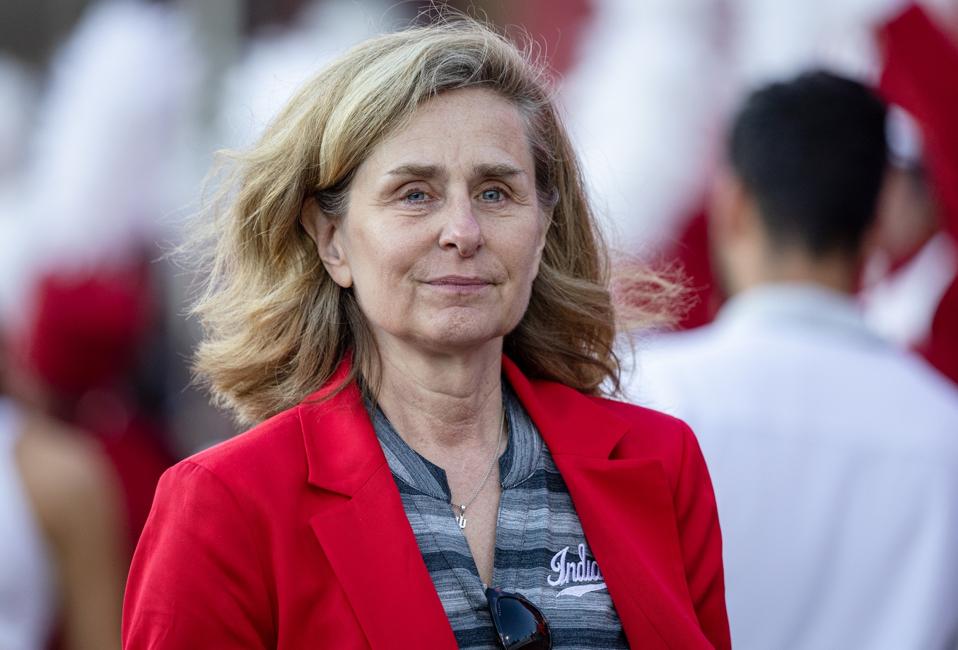The faculty at Indiana University (Bloomington) voted overwhelmingly on Tuesday in favor of no-confidence resolutions for IU President Pamela Whitten, Provost Rahul Shrivastav and Vice Provost for Faculty and Academic Affairs Carrie Docherty.
According to the Indiana Daily Student, with almost 900 faculty attending the meeting, the votes of no confidence passed by huge margins for all three administrators:
- 93.1% voting no confidence in Whitten,
- 91.5% voting no confidence in Shrivastav,
- 75% voting no confidence in Docherty.
The votes came following several controversies that have engulfed the IU campus during the past year. Alleging that the “current IU administration is encroaching on both academic freedom and shared governance,” a petition calling for today’s meeting and historic votes cited several examples of conduct that were objectionable, including;
- Cancelling an art exhibit at IU’s Eskenazi Museum of Art by Palestinian artist Samia Halaby over concerns about the artist’s pro-Palestinian social media posts regarding the Israel-Gaza war;
- Suspending political science faculty member Abdulkader Sinno for misrepresenting a Palestine Solidarity Committee event on a room reservation form and for conducting the event without university authorization;
- Attempting to spin off the Kinsey Institute from IU, a move that was ultimately not pursued;
- Refusing to publicly support IU faculty member Dr. Caitlin Bernard, an obstetrician-gynecologist who had provided an abortion for a ten-year old rape victim and was then the target of inflammatory comments by Indiana Attorney General Todd Rokita;
- Disregarding a 2022 faculty vote in support of unionization efforts by graduate student workers; and
- The administration failing to “proactively and effectively stand against the Indiana legislature’s violations of academic freedom and faculty protections.”
The votes of no confidence for Whitten, Shrivastav and Docherty were held separately. According to the rules regarding such votes, if more than 800 faculty attended Tuesday’s meeting, the votes could be taken immediately. If more than 200 but less than 800 faculty attended, the resolutions would have been debated and the faculty would vote electronically later. An IU spokesperson said the total voting pool was 3,276, meaning fewer than 30% of eligible faculty cast a vote.
While the no-confidence votes by the IU faculty carries no legal or official authority, they’re likely to have consequences nonetheless. No-confidence votes are a dramatic indication of a faculty’s dissatisfaction with an institution’s leadership, and they are not easily ignored by a president or an institution’s governing board. They also tend to be rare at universities with the stature and reputation enjoyed by IU.
At Indiana University, the last no confidence in the university president was taken in 2005 against Adam Herbert, who ultimately decided to retire after the end of his initial contract.
The reasons for no-confidence votes vary from institution to institution. The most common scenario behind such votes recently has been faculty displeasure with large-scale academic restructuring and budget reductions directed by presidents, provosts and boards of trustees.
At IU, while the administration’s financial management had come under faculty fire, the larger concern appeared to be faculty perceptions that Whitten’s administration has shown insufficient regard for protecting faculty against outside attacks, upholding shared governance and standing up for the institution’s autonomy in academic affairs. Similar concerns have surfaced recently at other major universities, as disputes about the academic authority of faculty and administrators become more elevated.
After the vote, Whitten issued a statement to the faculty addressing “how we can move forward together.”
The statement acknowledged, “while we will not always agree, our community is made stronger by an array of viewpoints and voices—including those expressed as part of this process.”
Writing “there is no going back to an earlier time,” Whitten pointed to demographic changes, financial realities, and political developments that are accelerating and mark the new higher education environment. She added that “against this backdrop, our trustees have charged us with making difficult but necessary decisions to ensure that IU, and IU Bloomington, as the flagship, emerges as a leader among elite research universities.”
She encouraged the faculty “to suggest innovative opportunities within your department, school or college to share your ideas. In turn, I pledge to listen and learn. I will weigh the guidance from faculty council and the participation of the campus community through shared governance to achieve our collective vision of a thriving campus.”
The Board of Trustees also issued a statement indicating that “at our direction and with our support, President Pamela Whitten is leading at a time in higher education where the status quo is not an option. It is against this backdrop that we proudly endorsed IU 2030, the university’s strategic plan outlined by President Whitten and her administration, which was designed with faculty and staff participation on every campus.”
The statement added, “as a Board, we continue to offer our full support to President Whitten. She is the right leader at the right time precisely because she has pursued a future for Indiana University that will ensure that it thrives in its next era. It is our intention that President Whitten’s tenure as the leader at IU will provide the many years necessary to realize the vision we have established for the university.”
The Board said it stood “united in our confidence in President Whitten and the long-term success of IU. By acknowledging the realities of today’s world and working collaboratively, we are poised to collectively accelerate the achievement of our goals. This shared commitment fortifies our resolve to usher Indiana University into its next century of success.”


 Download iOS app
Download iOS app